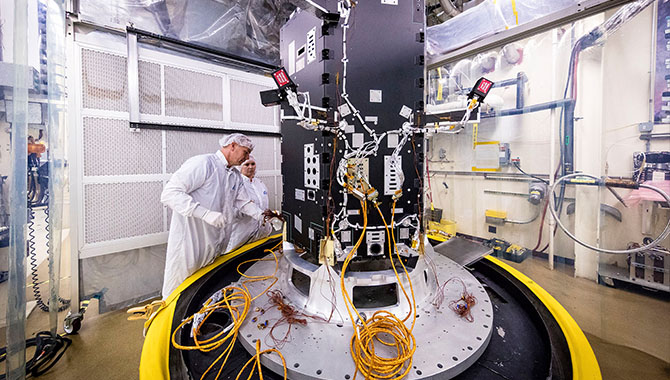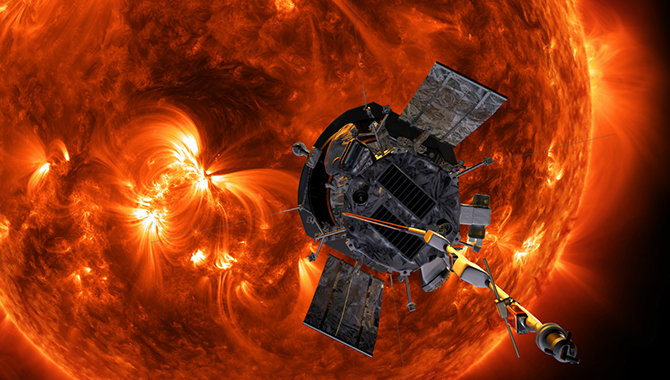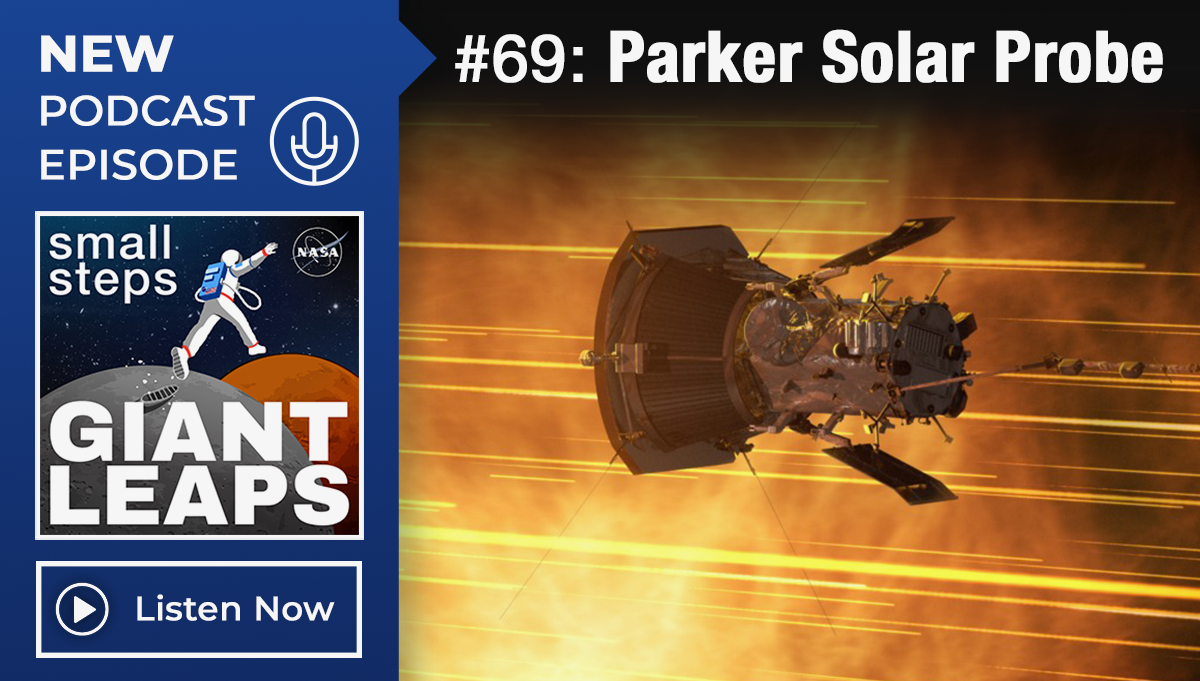
The Parker Solar Probe will fly through the Sun’s corona 24 times during an ambitious mission to learn more about our star.
Credit: APL/NASA GSFC
Innovative solar probe will push the boundaries of human achievement while exploring the hostile atmosphere of the Sun.
The sun has been a source of mystery throughout human history. Although scientific understanding of our solar system’s star has increased greatly in the past century, perplexing questions remain. Later this summer, NASA will launch the Parker Solar Probe, an ambitious mission to fly through sun’s corona 24 times to answer some of these most vexing questions.
“The sun is incredibly dynamic, always changing, and always in motion,” said Alex Young, the associate director for science in the Heliophysics Science Division at NASA’s Goddard Space Flight Center. “It goes through periods of incredible violence, and relatively calm periods. But it’s an incredibly dynamic star.”
This dynamism is behind two of the key questions on which scientists hope to gain understanding from the mission — solar winds and solar storms. The stream of electrons, protons, and alpha particles released from the corona, known as the solar wind, can impact Earth and space missions. They vary from a steady subsonic “breeze” to a supersonic flow.
“Why does this happen? Why is the solar wind so fast?” asked Young, speaking at a press briefing about the upcoming mission. “We want to understand why this happens in the corona.”
Young noted that in some cases, billions of tons of solar atmosphere, threaded with solar magnetic fields, travels away from the Sun at millions of miles per hour. Understanding the causes for this is crucial to help NASA develop better models to predict such events and protect spacecraft, astronauts, and even communications systems and power grids on Earth.
Scientists also want to gain a better understanding of the corona itself, which defies expectations by being millions of degrees hotter than the surface of the Sun. “The science is groundbreaking, it is compelling, (and it) has confused scientists and puzzled us for decades and decades and decades,” said Nicola Fox, project scientist for the Parker Solar Probe from Johns Hopkins University Applied Physics Laboratory (APL), speaking at the same briefing.
The probe is named after Eugene Parker, an influential solar astrophysicist who published a seminal paper on solar wind in 1958. The probe is the first NASA mission ever named after a living person. The team expects Parker to be at Kennedy Space Center for the launch in August.
By any definition, the mission is extraordinary. As the probe flies through the Sun’s corona in a series of 24 petal orbits, the spacecraft will reach a peak speed of a staggering 430,000 miles per hour, making it the fastest humanmade object ever. At its nearest point, the spacecraft will be within 3.83 million miles from the Sun’s surface, flying through the corona, portions of which can reach temperatures of 3 million degrees.
The probe will be carried into space via a United Launch Alliance Delta IV Heavy rocket, a “beast of a rocket,” Fox said, with a third stage to quickly move beyond the Earth’s influence. Six weeks into the mission, the spacecraft will encounter Venus for the first of seven times using its gravity to brake and turn.
An improbably thin, lightweight heatshield will protect the spacecraft during its close encounters with the Sun. This Thermal Protection System (TPS) is 8 feet in diameter and less than 5 inches thick. It comprises two superheated carbon-carbon panels with a lightweight 4.5-inch-thick carbon foam core. It weighs just 160 pounds but can withstand heat of 2,500 degrees Fahrenheit. With the shield in place, the temperature of the spacecraft and scientific instruments will remain an Earth-like 85 degrees (F).
The probe carries a full suite of instruments to take and record the measurements that are crucial to answering the scientific questions of the mission. Instruments will measure magnetic and electric fields, count the electrons, protons, and helium ions in the corona and measure their velocity, density, and temperature. And a Wide-Field Imager, the only camera on the probe, will look for large events in the corona that can then be linked to the observations of other instruments.
Because it takes sunlight eight minutes to reach the Earth from the Sun, and the probe will actually be physically blocked from communicating by the Sun at some times, the probe is equipped with a highly autonomous system of sensors and controls to quickly reposition as it flies through the chaos of the corona.
“We have placed solar sensors all over the spacecraft to determine when it’s receiving too much sunlight. Autonomy then determines how best to position the spacecraft,” said Patrick Hill, deputy project manager for Parker Solar Probe from APL.
The mission is part of NASA’s Living With a Star flight program, managed by Goddard Space Flight Center in Greenbelt, Maryland, for NASA’s Science Mission Directorate in Washington, D.C. The Johns Hopkins University Applied Physics Laboratory implements the mission for NASA. Scientific instrumentation is provided by teams led by the Naval Research Laboratory, Princeton University, the University of California, Berkeley, and the University of Michigan.










